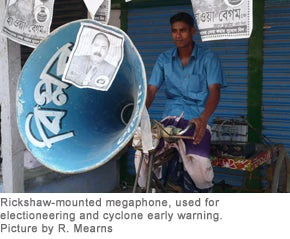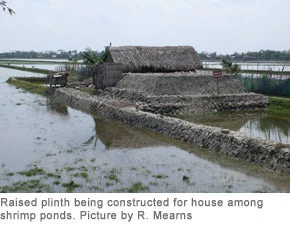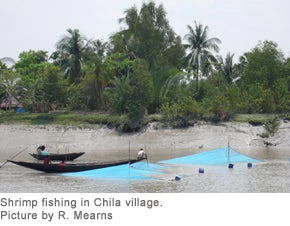
This week in Dhaka, over 350 people from 60 countries met to exchange knowledge on ways to meet the challenge of scaling up community-based approaches to climate change adaptation. This was the fifth such international conference, organized by the Bangladesh Center for Advanced Studies (BCAS) and the International Institute for Environment and Development (IIED), and supported by 37 other international NGOs and bilateral and multilateral development agencies including the World Bank. In her inaugural address, the Prime Minister of Bangladesh, Sheikh Hasina, called upon participants to come together in a spirit of mutual learning, not just from each other, but also from the communities that a number of us visited during three days of field visits.
The trip I joined to Chila took place on an historic day. Over the holiday weekend marking this young country’s 40th anniversary since independence, local elections were also taking place for the first time in 12 years. On the way to the ferry, our bus driver took us on an unannounced detour so he could go and vote. Once in Chila, we talked with community members at the local market and in their homes, often precariously balanced between shrimp ponds, stretching as far as the eye can see, where not so long ago there were only rice paddies.

What we saw of local NGO efforts was clearly of great value to poor households struggling to meet daily needs such as drinking water and flood protection. Their livelihoods are not well adapted even to existing climate extremes, let alone to future climate changes. But some of the immediate and pressing livelihood concerns they face have less to do with climate change than with other, underlying causes of vulnerability. Rising salinity, for example, may have more to do with the impounding and extraction of fresh water up-river, thereby allowing salt-water to intrude further inland; and to the conversion of rice paddies to shrimp ponds, which has arguably led to a narrowing of livelihood (or adaptation) options open to people in Chila, both today and in the future. It seemed likely that a threshold would eventually be reached when in situ adaptation measures within Chila would no longer be sufficient, and when options further afield – such as temporary wage labor migration or even more permanent forms of voluntary migration – might increasingly be needed.

Scaling up CBA isn’t a question of simply stitching together a ‘patchwork quilt’ of local initiatives, as IIED’s Saleemul Huq, one of the conference organizers, aptly put it. This could be a recipe for maladaptation in many places. But the real contribution of the CBA movement in recent years has been to show that top-down approaches to adaptation will also founder if they fail to connect with the felt priorities of those most vulnerable to climate change.


Join the Conversation